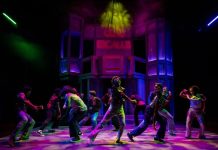Total Verruckt! presents the real-life story of members of the Camp Westerbork Theatre Group, an unlikely troupe that was formed at the Westerbork Transit Camp – a Nazi transport and detention center in the Occupied Netherlands during World War II. From 1942 to 1944, alongside thousands of other prisoners, some of the day’s most talented and famous Jewish actors, singers, writers and cabaret performers came through Westerbork on their way to Auschwitz-Birkenau, Bergen-Belsen, and other death camps.
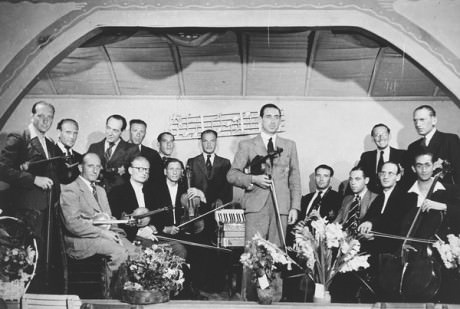
Inspired by the diaries of Jewish-Dutch poet Etty Hillesum and others, Total Verruckt! creator and performer Joanna Caplan shows that in the face of terrible conditions and almost unimaginable despair, performers like Max Ehrlich, Johnny & Jones, and Dora Gerson created art. They used this art as a means of survival, an act of resistance, and a gift to ease the suffering of their fellow inmates during some of their hardest times.
Joanna and I recently talked about her creative process for developing this show, her inspirations for doing so, and how she prepares for the weighty task of embodying a number of the courageous performers of the Camp Westerbork Theatre Group. Her one-woman show runs this week at Baltimore Theatre Project, with a total of 5 performances between December 3 and 6, 2015.
Patricia: How long has Total Verruckt! been in development?
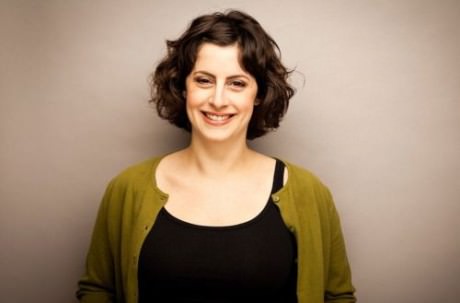
Joanna: I’ve been at Double Edge Theatre and have been working on the piece since 2011. It premiered in 2013 and I have been touring it from 2013 to now.
Had you ever worked with Double Edge Theatre before?
I went there for the first time in 2009. I participated in a three-month immersion program where you’re training with the company and developing your own training, your own practice, and your own ideas of what your research is – a very individualized program. It was a very transformative experience for me.
It was at that time, in 2009, when I first picked up Etty Hillesum’s diaries and that was the moment when I was like “Wow, this is something I’m really interested in and I want to work with.” So I had this idea in 2009 that I was going to make this one person show based on the diaries of a Etty Hillesum, and also around that same time I found out about the Westerbork Camp and the Westerbork Theater Group. Those two things really got everything going for me.
I left Double Edge Theatre after the three months and moved to Toronto. I’m from Montreal, but I moved to Toronto and I was there for a year and a half where I wrote a lot and started developing a performance. Then I went back to Double Edge Theatre in 2011 to work on it in greater depth.
Patricia: The show’s formal premiere was in 2013. Had you performed it publicly before that?
Yes, at the 2011 Toronto Fringe Festival. I performed what I call a skeletal version. It was the first incarnation of it.
Like a workshop version?
Yeah, exactly. And that was after working on it for six months or so at Double Edge Theatre. After that, I came back. My now-director is Matthew Glassman, who is one of the co-artistic directors at there. He had been working on the show with me before, but not as a director. Matthew said he was interested in directing if I wanted to continue working on it. That sounded great so we ended up working on it together.

Where did you get your source materials, other than Max and Etty’s diaries?
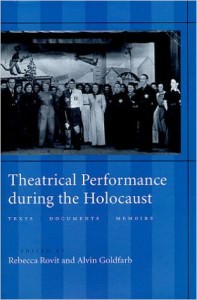
The show is very deeply rooted in history, but I made it my own dialogue with it. It’s my journey with these people and their work. And in some way, it’s about the imagination. How did the work of Etty and Max and Dora and Johnny & Jones somehow transcend history, be more than in a book? How does it become alive? And how do I relate to it as a young Jewish woman? How do I preserve their work?

Etty Hillesum was just 29 when she passed away. All her work is done. She was a brilliant, amazing writer and it’s just weird to think about that. I’m 31 and I was working on the show when I was in my 20’s. I felt a very strong connection to her.
When I remember how young some of the people were, aside from all the other reasons it’s tragic, I think about how much of that generation’s creative imagination was lost. One of the reasons I was happy to hear about your show is that we’ll be able to get a glimpse of that talent – of what people were still capable of doing under unimaginably difficult circumstances.
I think that if there was a thesis for the show, it would be “how do you make art survive?” It was really interesting, emotionally and spiritually, how art somehow helped these people stay alive. I know for me, as an artist, that making art helps me find meaning in my life. Reading Etty’s work, she even says how she finds meaning by writing, so there’s that aspect of it. Also, they would perform after the transports left from Westerbork. Usually on Tuesdays, the transports would leave Westerbork taking the people to Auschwitz, Theresienstadt, and Sobibór – the death camps. So afterwards, they would perform the shows for their fellow inmates; it was a way of finding some kind of upliftment among the horrific moments.
In another way, I think it actually literally helped some people survive. Every week, you wouldn’t know who would be called to transport. A lot of these performers ended up delaying their deaths because they served a purpose at the camp so they were kept there to put on performances. They got to live a little longer. There’s a lot of layers to it.
You said you originally heard about Etty and Westerbork when you were at Double Edge the first time, in 2009. How did you come across it? Is there a library there?
Double Edge has a space called The Pavilion. The Pavilion serves as a training space and also a reception place and an archive. At that point – and still – we have a lot of books and bookshelves. There was a lot of time given to individual work in the program. The students spend time looking through books and images and you are doing research on things that interest you. I just found it in the bookshelf and started reading it. Around the same time, I started becoming interested in people who made art under dictatorships, thinking about Communist Russia, and then I found out about the camp at Westerbork and I couldn’t even believe it that that actually happened. It’s been a very amazing journey.
I watched the mini-documentary about Double Edge Theatre. That is an extremely demanding amount of physical training. I bet any of of you could qualify for the Olympics as much as you train! It looks like Double Edge Theatre may not present the most direct path to where you’re going, but certainly the richest and most fulfilling.
Yes, absolutely. It’s an amazing place.
This is a cool fact: I made the show in an attic. Double Edge is based on 105-acre former dairy farm. The student housing is up the road about half a mile and in this student housing there’s a storage place, this old garage or attic in a very old farmhouse. I asked them and they said I could work in the attic. It’s unfinished and very cold in the winter and hot in the summer, but I ended up making an artistic home there. For two years, I worked there and trained there. I put up this ladder that has become one of the centerpieces of the set.
Matthew, my director, would come there and watch and we’d talk about the show. It almost in someway sounds cliché; because it’s an attic, you think of Anne Frank, but it had a real personality. The attic was almost like a partner. Because it’s a solo show, it’s really easy to get all wrapped up in yourself, but I had the partner of the wood of the attic and the cold in the winter time. They became these partners for me.
If I had seen your show at the Toronto Fringe in 2011 and then I go see the show this Thursday, would I recognize it? Is it just a much more fleshed out version? How has it developed over the last four years?
You would recognize the scenes, but they’d be like little seedlings, like little mini tree versions or baby versions of what they are now. The structure and the characters were all there in 2011, but now obviously they’re way more fleshed out.
I wouldn’t say the show is lengthier per se, in a conventional sense, but I think there is way more of a through-line. Some of the props I use are the same, like the suitcase and Max’s hat, the train tracks – those are all the same. Some of the music is the same. It’s grown a lot and I’ve also worked with different people since 2011. I’ve had people collaborating with me, like my friend Sarah Cormier, who is also a resident artist at Double Edge Theatre. She designed the set based on the set from 2011 and the attic space. She took that attic and made it tourable!
Originally, the show was very simple to set up. I remember in 2011, I was actually able to strike it and put it up in 15 minutes. Now, for better or for worse, it takes 2 1/2 days to set up the show because of the lights and the rigging and the set. It’s insane, but that’s just what happens.
So you started thinking about this show in 2009 and you’ve been touring it since 2013. The show and working with this idea has basically been the focus of your entire adult life. Do each of these people that you’re portraying seem like real people to you now?
It’s interesting that you ask that. With this kind of work, I can’t just pick up and perform it without having prepared. There’s a big preparation arc that needs to take place and I think one part of that has to do with the physical training. The show is really physically demanding and I have to train for it. Right now, in preparation, I’m running up hills four or five times in a row, just trying to get my stamina up. It’s very demanding.
Another thing that I do in preparation, because I can forget, is to come back to the fact that these people are real people. I can’t get caught up in my own interpretations of them or make them caricatures of themselves. Today I was rehearsing; I’ve actually gone back to rehearsing in the attic. These characters come out of maybe a fictionalized version or an imaginative version, but these are real people. I think it’s so important to always remember that. Something that I need to do on a daily basis when performing the show is to read their work and look at their pictures and think about their stories and meditate on their lives. Or else it doesn’t work, it’s just a farce and it can’t be a farce.
How many different characters are there represented in the show?
There’s five.
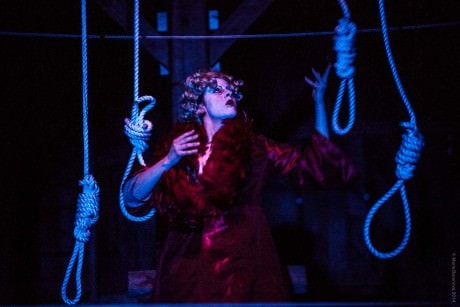
And Total Verruckt! was the name of the last show performed at Westerbork?
Yes. There’s not a lot that’s been written about their shows, but it’s been described as getting crazier and crazier as it went on. It became absurd and the acts had really ridiculous names like “The Hyena Goes to the Guillotine” or something crazy like that. The show is totally crazy – that is what the name of the final show means – and that was the reality of it. Everything was just falling apart. I wanted to bring that aspect of it, that spirit, into what I was doing.
When you’re done with doing a run of the show, what is the emotional cost to you? What do you do to set these people aside for a bit so you can be Joanna again?
I have a yoga practice, so I continue doing that. It’s very important to me. And I will rest and sleep and I guess I’ll just get back to my life. I don’t really take breaks; I’m not good at that. Everyone who works at Double Edge as a performer, also works in the business areas, so I manage the box office and I manage the main office. I deal with hospitality and guests, a lot of information systems, our database… it is very busy, so I’ll just sort of go right back into that. But, as I said, my yoga practice is really important. I have to remember to breathe and relax a little; the show is very demanding and I feel it takes a lot out of me. It seems to be taking a little more out of me now than when I performed it before. I don’t know if it’s the time of year or if my physical health is a bit different or what.
I had never heard of Westerbork before learning about your show and I believe you will probably be the first contract that most people who come to this show will have with phenomenon that occurred there. What do you hope to do with the show in the future?
Somehow I want to continue touring the show. I would love to be able to perform it in schools for students. The survivors are passing away; they’re going to be gone soon. Telling this story is something I’m very committed to. Maybe it’s because I’m Jewish, or a woman; I don’t know why, but I feel very strongly that I need to tell the stories. I’ve also been feeling lately like the next step is to somehow get to Westerbork or to the Netherlands and to meet these people, to just talk to them. I don’t know what would come of that, but it’s something I’ve been thinking of a lot because they’re going to be gone.
It is important to make sure that this is something that is remembered. They say if you don’t learn from history, you will repeat it. At this point in history, I feel like we haven’t forgotten, but we just don’t seem to have fully learned from this yet.
Yeah, when you think of the refugees and what different countries are doing. What’s going on here. Can we get it together?

It’s weird to remember that Westerbork actually started out as a Jewish refugee camp and then, after the occupation, it became a prison and transit camp. It seems unfathomable that something like that could happen now. Do you hope that this show may have some sort of additional significance to people considering what’s going on in the world today?
Yes. For other people to see it and think about the parallels and, for myself, even to remember that this happened; it’s an historical event. But there are things happening now that are horrible. It’s a very powerful reminder. We read in the news about the refugees and we see photos and you just become numb to it. I think it’s important to think about it in different ways.
I often think of myself in the context of the show and I wonder if I were there at that time, who would I be? Would I be a fighter? Would I be a coward? Would I just survive? Would I help others? I just don’t know. But then I think about myself now. I’m not very political. Obviously, I care about things very deeply, but I don’t go to protests. I’m not into that stuff. When I think about it, it forces me to ask these questions again. Who am I in this world? What am I doing? How am I making a difference and how am I standing against things that are wrong?
The show sounds like it can open up a lot of thinking and dialogue about important questions like that. I can see that your show has been performed in many cities, but it doesn’t appear that you have a continuous sort of tour going. Do you have another performance scheduled for after you leave Baltimore? On your way back to New England, are you hitting Philly or something like that?
No, I’m not, for a couple reasons. One is that at the theater at Double Edge, we also do other projects, so we have a summer performance that we’re in rehearsals for. Through the summer, we’re booked with that and a lot of the festivals I might tour happen in the summer. So I can’t do that kind of thing and, like I said, it’s a really big show now and it takes a lot of time to put it up. It’s not something I could do at Fringes anymore unless I could have my own space because once the set’s up, it’s up. I couldn’t strike it to share a space.
Also, even a week long tour is pretty intense. It’s very rigorous. The thought of going city-to-city with it would be a lot of work. Now, with one tour every six months, in some ways it works for the show because it’s so intense; but at the same time, I’d love to go more places with it. I have been talking to a man in Arizona who is with a Jewish foundation. He read about the show I did in Detroit and he’s trying right now to find ways to bring me there maybe next Fall. I really want to bring it home to Canada – Montreal and Toronto. It’s proving difficult though because I don’t want to self produce. I’d like to find a place to bring me in.
A couple closing questions based on major themes of your show… First, why is art necessary?
For me, art is necessary as a means of survival. I live in peace and I’m really privileged, but for my own mental and emotional survival, I need to make theater. I’ve learned that I need to make art. I’m not going to feel like I’m living a meaningful life if I’m not engaging with art, questions, and with the world. I think that’s what really drove me to this material. This is the question and it’s articulated in so many different ways. In the context of the holocaust, it can be articulated through the impact of art with the Westerbork Theatre. It’s articulated in my personal life. When I get depressed or when I’m not happy, it’s because I’m not making art or making the right art.
Finally, some of your press materials talk about art as a means of survival and an act of resistance. I know the people at Westerbork weren’t able to overtly make reference to the Nazis, but they certainly snuck things in there. In today’s world do you feel that art is an act of resistance?
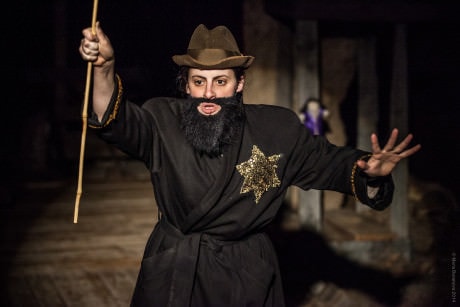
I do, 100%. Being at Double Edge, we don’t live off the grid; we have electricity and Internet, but it’s definitely an alternative lifestyle. It’s an idea of the living culture, which is an idea of an active community of people who are taking charge of their lives and doing meaningful things. I think that just being at Double Edge in some ways is my way of being like, “Okay, I’m living my life in this way.” It’s different from capitalism or consumerism. It’s very different, so I think in that way, it’s an act of resistance. I’m resisting what I think is wrong with our society right now. I’m not like an anarchist or anything. I don’t believe in no government and I enjoy shopping and I like pretty things, but it’s important to remember that that’s not everything. For me, when I’m at Double Edge, it reminds me that there are more important things. There’s a bigger fight, which is quality-of-life and community and relationships. That’s not important to a lot of people. If you ask people what’s most important, maybe people will say family or friends, but I feel like for some, it’s really money or status.
It sounds like at Double Edge Theatre, you’ve really found a group of people who recognize that we are all interrelated. There’s really no fundamental difference between any of us and if we choose to, we can work together and make things better for everybody and do the things which are most fulfilling in our lives. I applaud you for that and I’m happy that you found a home there. It sounds like you’re all making amazing art. I’m looking forward to seeing your show on Thursday.
I’m so excited! I’m looking forward to people to seeing it. And I’m glad that we did this interview because it’s so nice to talk about it all and to have an opportunity to reflect.
Total Verruckt! plays December 3-6, 2015 at Baltimore Theatre Project – 45 West Preston Street, in Baltimore, MD. For tickets, call the box office at (410) 752-8558, or purchase them online.


